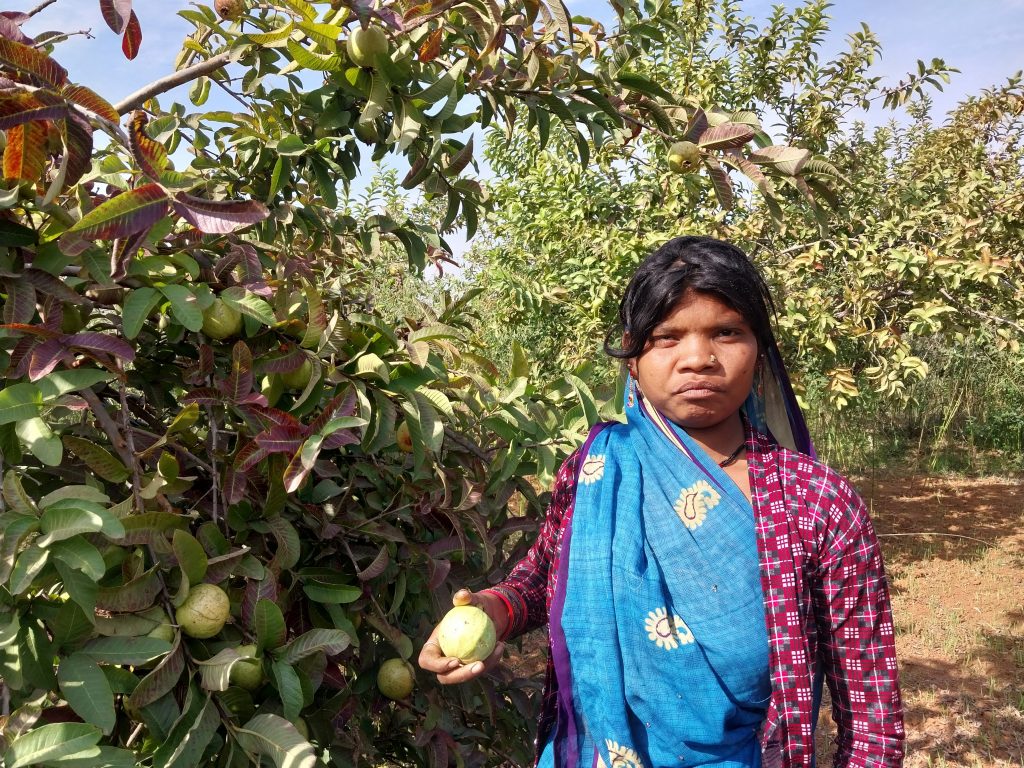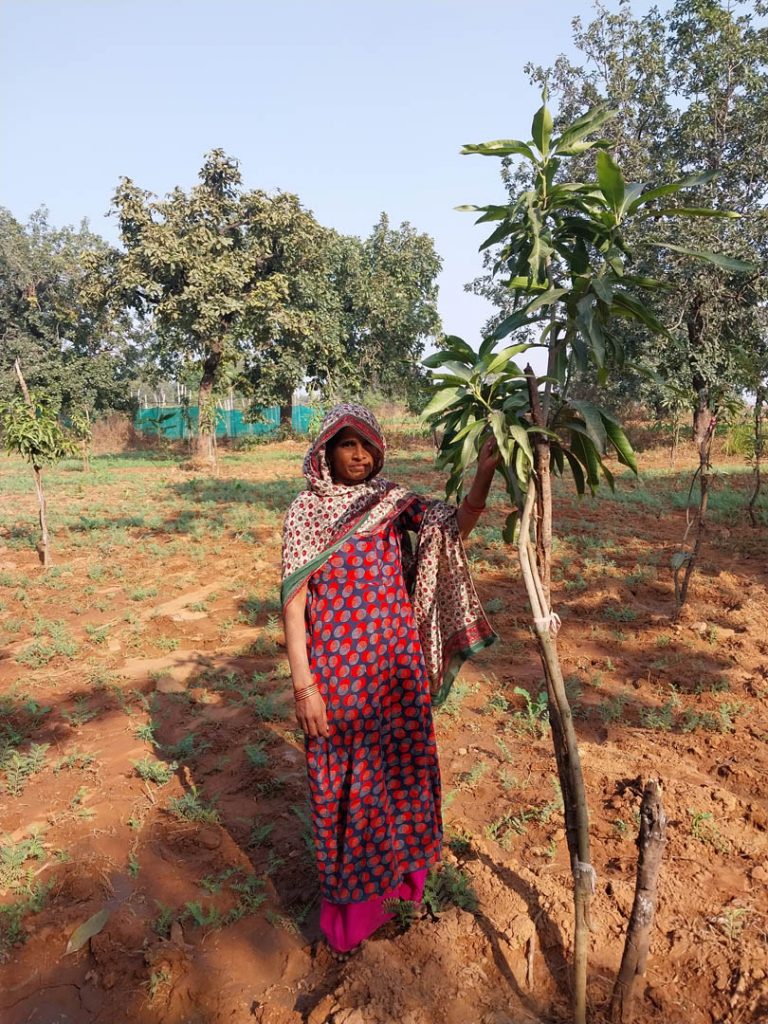
In several villages of Damoh and Chhattarpur districts of Madhya Pradesh, which come under the dry Bundelkhand region, farmers are experimenting with fruit trees alongside crops. A report by Deepanwita Gita Niyogi
Sukka Bai, a Bhil Adivasi woman, is a resident of Surajpura village in Madhya Pradesh’s Damoh district. On a sunny afternoon, Bai proudly showed around her favourite crops in the field: bright red chillies and luscious tomatoes.
“Click a few good photos of the chillies,” said Bai, who spends a major part of the day in her land spread over a few acres. Apart from these two crops, the woman also has a few vegetables and chickpea.

“Earlier, farmers in my village could not grow two crops a year. So, in winter, families migrated for work as they failed to cultivate wheat due to water scarcity,” said Bai, who has herself worked in Rajasthan and Gujarat for a meagre Rs 300 per day. But the pandemic changed that. “I have not stepped outside since then.”
To help farmers improve their farm income, non-profit Haritika has distributed saplings of fruit trees like guava, mango and the Indian gooseberry. Bai’s plants are yet to bear fruits but she has started taking good care of them.
Two days before visiting Sukka’s house in Surajpura, guide Natthu Pal accompanied the reporter to Kishangarh gram panchayat dominated by the Rajgonds. Pal pointed out that as part of natural resources management in the water-scarce Bundelkhand region, trees were planted, check dams constructed and water bodies created to help in irrigation. “Besides, Peyjal samitis have been formed in villages for water supply through borewells to individual houses. In many villages, small in size and surrounded by forest all around, water tanks have been built for storage,” said Pal, who has been working in Haritika for over a decade.
Taking care of irrigation needs
In Bundelkhand, water harvesting structures are the biggest assets as they help in cultivation during the winter months. Monsoon rainfall helps farmers carry out Kharif season cultivation whereas water stored in talabs (ponds and reservoirs) ensures wheat irrigation during the Rabi season.
Near a huge talab called Amarkund, farmers Surender Adivasi and Hakka Adivasi informed they were residents of Jharkuwa village, about a kilometre away from the spot. This time, both of them have sown wheat and chickpea.
“In monsoon, we grow oilseeds (til) and urad (black gram). Farmers could not grow wheat before. The talab was dug around 2013. Since then, farmers from two villages, Jharkuwa and Ganeshganj, have benefitted from water supply from the talab in Rabi,” said Hakka.
His friend, Surender, explained that earlier, many people relied on goats for income or went to work in Delhi and other big cities for Rs 200-Rs 300 per day after the Kharif harvest. “People migrated as borewells are not a success at many places.”
At the talab which was almost on the verge of drying up, there was a flurry of activity as several people tried to catch fish. “The region gets adequate monsoon rainfall. As a result, the talab was full of water even a few months back. Wheat crop sometimes matures with fewer number of irrigations but at least five times is best. As water has fallen short, winter rains will be a boon now,” added Hakka. A farmer named Kumma Adivasi, who owns five acres of land, said he could afford to irrigate his wheat crop only two times.
Benefit of extra income
Keeping in mind such situations, farmers across Chhattarpur and Damoh districts are being encouraged to grow fruit trees for additional income throughout the year.
At the orchard of Manta Adivasi, ripe guavas are ready for consumption. Apart from guava trees which dominate her orchard, the woman also grows amla trees.
Pal explained that after digging a borewell and fencing the entire area for safety, Manta’s land was covered with seasonal crops and fruit trees. Manta on her part cooks at home and comes to stay at a small and neat hut constructed in her land to keep watch.
A resident of Patna village in Chhattarpur district of Madhya Pradesh, Manta informed that her husband had migrated for work. “My mother in-law sells the guavas in the market.”
Chhotelal Adivasi, another resident of Patna village, said the average yearly income of many families from farming stands at Rs 20,000-Rs 25,000. Many also engage in labour work and gather tendu leaves as well as mahua flowers from forests.
In Purba, located near Patna village, Paramlal Adivasi, a former sarpanch, admitted that the fruit trees had been of huge help. “There is no extra space needed to grow the trees as they share space with crops. But water is an issue in the village and borewells work for an hour only. Wells are not a success here as the surface is rocky,” said Paramlal, who cultivates chickpea and wheat in winter on his four acres of land. In monsoon, urad and til are his preferred crops.
In Sukka’s village, farmer Jamna Adivasi has sown barley which needs less water. He said that this time the monsoon was not adequate. Farmers in the village get irrigation water from a huge talab, said Haritika staff member Shubham Pathak. About 70 farmers benefit from it. Jamna’s barley needs just one more irrigation. In the Kharif season, he sows maize and gets 10 quintals of produce, out of which he keeps about five quintals for consumption.
Sukka is not interested in migrating anymore. “People used to migrate but now they can grow two crops a year. If I go away, who will take care of my trees and crops?” In a few places, multi-layered machans have been built to support creepers like bottle gourd.
Avani Mohan Singh, executive director at Haritika, said about 80 villages have been covered in some four districts of Madhya Pradesh. The number of trees stands at 10 lakh with 750 trees planted per hectare. “Fruit trees were procured from private nurseries and distributed to farmers. The beneficiaries will be able to take carbon credit after five years.”












